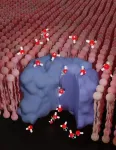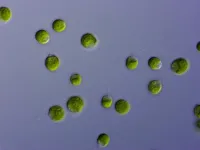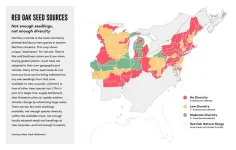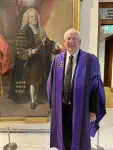(Press-News.org) New York University researchers have discovered new cell types in the visual system of flies, made possible by their creation of a tool that finds and labels neurons during development.
The study, published in the journal Proceedings of the National Academy of Sciences (PNAS), combines single-cell sequencing data with a novel algorithm to identify pairs of genes that point to previously unknown cells in the brains of fruit flies.
Fruit flies (also known as Drosophila) have long been used as a model organism to study fundamental questions about the development and function of the brain. Instead of the 86 billion neurons found in humans, fruit flies have about 100,000 neurons—making research into the brain a more manageable, yet still complex, endeavor.
The use of genetic tools that can distinguish different types of cells in fruit flies has revolutionized the study of neural circuits in the brain, allowing scientists to understand circuit development, function, and behavior in a precise manner.
“A hallmark of the central nervous system is the diversity of different cell types that are responsible for so many different functions,” said Claude Desplan, Silver Professor of Biology and Neural Science at NYU and the study’s senior author.
Previous research in Desplan’s lab used single-cell sequencing to determine that there are approximately 200 cell types in the developing fly’s visual system. Single-cell sequencing reveals gene expression, so when cells have the same gene expression patterns, they are likely doing the same job and are therefore the same cell type.
Scientists could identify roughly half of the 200 cell types in the developing fly’s visual system based on their gene expression and prior studies, but they lacked a way to more easily study and label the other 100 cell types. Existing tools that allowed precise manipulation of neural circuits of adult fruit flies often failed to label the same neurons during development, rendering these tools unfit to study cells in the developing brain.
“Moreover, the previous approach to identifying cell types involves laborious testing of numerous gene candidate combinations. We knew we needed a much more efficient approach to label specific cell types, and were able to tap into the growing amount of single-cell sequencing data that is available,” said Yu-Chieh David Chen, a postdoctoral associate in NYU’s Department of Biology and the study’s first author.
Chen and his colleagues created a tool that takes advantage of the extensive single-cell sequencing data for the developing fly visual system to identify genes—and combinations of genes—that are exclusively expressed in certain cell types.
To find a cell type, researchers typically look for genetic markers, or single genes that are specific to a cell type. But often a gene will be expressed in multiple cell types, making it difficult to use one gene to differentiate between them. The tool the NYU researchers developed uses a slightly different approach: finding two genes that overlap only in one cell type.
By feeding single-cell RNA sequencing data into an algorithm they created, the researchers systematically identified pairs of genes that are uniquely expressed in the majority of cell types in the fruit fly’s visual system at multiple stages of development. One such gene pair led to the discovery of MeSps, a brand-new cell type.
“Despite a long history of studying the fruit fly’s visual system, we had never seen this cell type before,” said Chen.
While future research will delve into the development and function of MeSps—for instance, whether it detects color, motion, or other features of light—this avenue of research will be made possible by the new tools.
The researchers note that their tools can also be used to study other systems beyond vision in the developing fly, as long as single-cell data are available. Moreover, their logic of finding marker gene pairs instead of one single marker gene can be applied in research in other species.
“Instead of looking for a single good marker gene, a simple tweak of just looking at two genes can achieve high cell-type specificity,” said Chen.
“This pioneering and efficient approach provides exceptional tools for the field of neuroscience to investigate developmental questions with high precision,” said Desplan.
In addition to Chen and Desplan, study authors include Yen-Chung Chen, Raghuvanshi Rajesh, and undergraduate students Nathalie Shoji and Maisha Jacy of NYU; Haluk Lacin of University of Missouri-Kansas City; and Ted Erclik of the University of Toronto-Mississauga. The research was supported by grants from the National Institutes of Health (R01-EY013010, R01-EY13012, and F32-EY032750).
END
How flies develop sight: Scientists use single-cell sequencing to identify cell types in the visual system
Researchers discover new types of cells in the brain of developing flies thanks to a new method that creates cell-type-specific genetic tools
2023-07-31
ELSE PRESS RELEASES FROM THIS DATE:
Study reveals long-debated makeup of the molecules that help organize your cells
2023-07-31
For years, we’ve known that a special kind of molecular assembly known as a “polyelectrolyte complex” helps your cells keep themselves organized. These complexes are very good at forming interfaces to keep two liquids separated: your cells use them to create compartments. These abilities have led scientists to consider them for technological applications, including filtering water, better batteries, and even underwater glue, as well as for better pharmaceutical drugs.
But for decades, no one knew exactly ...
How to distinguish slow and fast earthquakes
2023-07-31
Researchers from the University of Tokyo and Stanford University show what differentiates slow and fast earthquakes and how their magnitudes vary with time.
Normally, earthquakes last up to a few minutes and radiate strong seismic waves. But around 23 years ago, scientists discovered an unusual slow-slip phenomena called slow earthquakes. Slow earthquakes last days or even months. Though they involve significant tectonic movement, you may never feel them. Since slow earthquakes could indicate future fast earthquakes, monitoring and ...
Research shows filter tip stent retrievers may allow neurointerventionalists to remove blood clots on the first try during stroke treatment
2023-07-31
FOR IMMEDIATE RELEASE: July 31, 2023, 12:00 P.M. PDT
CONTACT: Camille Jewell
cjewell@vancomm.com or 202-248-5460
Research Shows Filter Tip Stent Retrievers May Allow Neurointerventionalists to Remove Blood Clots on the First Try During Stroke Treatment
SAN DIEGO—Research presented today at the Society of NeuroInterventional Surgery’s (SNIS) 20th Annual Meeting shows that different types of stent retriever tips may result in improved patient outcomes when performing mechanical thrombectomy to treat stroke.
Ischemic stroke, one of the most common types of strokes, happens ...
Nuclear spin's impact on biological processes uncovered
2023-07-31
A research team led by Prof. Yossi Paltiel at the Hebrew University of Jerusalem with groups from HUJI, Weizmann and IST Austria new study reveals the influence of nuclear spin on biological processes. This discovery challenges long-held assumptions and opens up exciting possibilities for advancements in biotechnology and quantum biology.
Scientists have long believed that nuclear spin had no impact on biological processes. However, recent research has shown that certain isotopes behave differently due to their nuclear spin. The team focused on stable oxygen isotopes (16O, 17O, 18O) and found ...
Researchers use geospatial mapping to assist burn patients
2023-07-31
University of Texas at Dallas researchers are using geospatial mapping techniques to identify social and environmental obstacles in communities that might impede burn injury survivors’ reentry into society.
The project is designed to help patients with burn injuries better adapt to their lives after medical discharge, including improving patient access to transportation, employment, food and other necessities.
“Our study looks at how people who survive burn injuries reenter the community,” said Dr. Richard Scotch, program head of sociology and a professor of public policy and political economy in the School of ...
Diving deep: Unveiling the secrets of microalgae to cope with environmental challenges.
2023-07-31
Environmental change, such as ocean warming, alters resource competition and biodiversity. Thus, it is essential to understand how organisms respond to increased competition because changes in their size and metabolism affect the productivity of ecosystems.
Competition has long been recognized as a driving force behind rapid evolution. Still, until now, a mechanistic framework for identifying the specific traits that evolve and their trajectories has yet to be developed. Researchers at Gulbenkian and Monash University turned to metabolic theory, which explicitly predicts how competition shapes the evolution of metabolism ...
Plans to plant billions of trees threatened by massive undersupply of seedlings
2023-07-31
The REPLANT Act provides money for the US Forest Service to plant more than a billion trees in the next nine years. The World Economic Forum aims to help plant a trillion trees around the world by 2030. Many US cities have plans to shade their streets with millions of trees. Major government and private funding is being invested in planting trees as a powerful tool to fight climate change, protect water, clean air, and cool cities. In short, trees are hot.
But new research shows a troubling bottleneck that could threaten these efforts: U.S. ...
Hollings director honored as fellow of Royal College of Physicians
2023-07-31
Raymond N. DuBois, M.D., Ph.D., director of MUSC Hollings Cancer Center, has been inducted as a fellow into the Royal College of Physicians (RCP).
DuBois traveled to London, England, for the ceremony in July. He had been elected to the prestigious body prior to the COVID pandemic, which delayed the induction ceremony.
The Royal College of Physicians was established in 1518 by a royal charter from King Henry VIII. The college's founding aim was to professionalize physicians through an academic body that required a degree and an exam before ...
NIH launches long COVID clinical trials through RECOVER Initiative, opening enrollment
2023-07-31
EMBARGOED FOR RELEASE
Monday, July 31, 2023
Noon EDT
Contact
NIH Office of Communications and Public Liaison
NIH News Media Branch
301-496-5787
NIH launches long COVID clinical trials through RECOVER Initiative, opening enrollment
Today, the National Institutes of Health launched and is opening enrollment for phase 2 clinical trials that will evaluate at least four potential treatments for long COVID, with additional clinical trials to test at least seven more treatments expected in the coming months. Treatments ...
Johnson-Matthews receives funding for conference: VL/HCC 2023 Graduate Consortium
2023-07-31
Brittany Johnson-Matthews, Assistant Professor, Computer Science, received funding from the National Science Foundation for: "Conference: VL/HCC 2023 Graduate Consortium."
This award will support the Graduate Consortium at this year's IEEE Conference on Visual Languages and Human-Centric Computing (VL/HCC), which will be held in Washington, D.C. October 2-6, 2023.
Johnson-Matthews said, "This funding will support the ability for students across the country to come together, network, share their research, and curate advice on completing their PhD from senior members of the VL/HCC community."
VL/HCC ...
LAST 30 PRESS RELEASES:
Numbers in our sights affect how we perceive space
SIMJ announces global collaborative book project in commemoration of its 75th anniversary
Air pollution exposure and birth weight
Obstructive sleep apnea risk and mental health conditions among older adults
How talking slows eye movements behind the wheel
The Ceramic Society of Japan’s Oxoate Ceramics Research Association launches new international book project
Heart-brain connection: international study reveals the role of the vagus nerve in keeping the heart young
Researchers identify Rb1 as a predictive biomarker for a new therapeutic strategy in some breast cancers
Survey reveals ethical gaps slowing AI adoption in pediatric surgery
Stimulant ADHD medications work differently than thought
AI overestimates how smart people are, according to HSE economists
HSE researchers create genome-wide map of quadruplexes
Scientists boost cell "powerhouses" to burn more calories
Automatic label checking: The missing step in making reliable medical AI
Low daily alcohol intake linked to 50% heightened mouth cancer risk in India
American Meteorological Society announces Rick Spinrad as 2026 President-Elect
Biomass-based carbon capture spotlighted in newly released global climate webinar recording
Illuminating invisible nano pollutants: advanced bioimaging tracks the full journey of emerging nanoscale contaminants in living systems
How does age affect recovery from spinal cord injury?
Novel AI tool offers prognosis for patients with head and neck cancer
Fathers’ microplastic exposure tied to their children’s metabolic problems
Research validates laboratory model for studying high-grade serous ovarian cancer
SIR 2026 delivers transformative breakthroughs in minimally invasive medicine to improve patient care
Stem Cell Reports most downloaded papers of 2025 highlight the breadth and impact of stem cell research
Oxford-led study estimates NHS spends around 3% of its primary and secondary care budget on the health impacts of heat and cold in England
A researcher’s long quest leads to a smart composite breakthrough
Urban wild bees act as “microbial sensors” of city health.
New study finds where you live affects recovery after a hip fracture
Forecasting the impact of fully automated vehicle adoption on US road traffic injuries
Alcohol-related hospitalizations from 2016 to 2022
[Press-News.org] How flies develop sight: Scientists use single-cell sequencing to identify cell types in the visual systemResearchers discover new types of cells in the brain of developing flies thanks to a new method that creates cell-type-specific genetic tools






